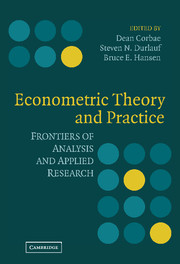Book contents
- Frontmatter
- Contents
- Preface: In Praise of a Remarkable Teacher
- Contributors
- Introduction
- PART I HIGHER-ORDER ASYMPTOTICS
- PART II IV SPECIFICATION TESTS
- PART III NONSTATIONARITY
- PART IV LAD AND QUANTILE REGRESSION
- PART V NONSTATIONARY PANELS
- 12 Combination Unit Root Tests for Cross-Sectionally Correlated Panels
- 13 Nonlinear IV Panel Unit Root Tests
- Index
12 - Combination Unit Root Tests for Cross-Sectionally Correlated Panels
Published online by Cambridge University Press: 05 June 2012
- Frontmatter
- Contents
- Preface: In Praise of a Remarkable Teacher
- Contributors
- Introduction
- PART I HIGHER-ORDER ASYMPTOTICS
- PART II IV SPECIFICATION TESTS
- PART III NONSTATIONARITY
- PART IV LAD AND QUANTILE REGRESSION
- PART V NONSTATIONARY PANELS
- 12 Combination Unit Root Tests for Cross-Sectionally Correlated Panels
- 13 Nonlinear IV Panel Unit Root Tests
- Index
Summary
INTRODUCTION
There have been several approaches to testing for a unit root in panel data. These include Quah (1994); Levin and Lin (1992); Im, Pesaran, and Shin (2003); and Choi (2001). All of these tests assume cross-sectional independence, although Im et al. (1995) consider a simple form of cross-sectional correlation using time-specific effects. It may be more appropriate, however, to assume cross-sectional correlation for some cross-country data sets because comovements of economies are often observed (e.g., Backus and Kehoe 1992) and cross-sectional correlation may affect the finite-sample properties of panel unit root tests as studied in O'Connell (1998).
In response to the need for panel unit root tests allowing cross-sectional correlation, researchers have devised various methods. Maddala and Wu (1999) bootstrap the critical values of Levin and Lin's (1992), Im et al.'s (2003), and Fisher's (1932) tests. Taylor and Sarno (1998) study the multivariate augmented Dickey–Fuller test. O'Connell (1998) considers a generalized least squares (GLS)-based unit root test for homogeneous panels. Chang (2000) applies bootstrap methods to Taylor and Sarno's multivariate augmented Dickey–Fuller and other related tests. All of these methods assume cross-sectional correlation in the innovation terms (eit in this chapter) driving the autoregressive processes in their models.
Here we propose unit root tests for cross-sectionally correlated error component models. Unlike previous studies, the cross-sectional correlation stems from error components, not from the innovation terms of autoregressive processes.
- Type
- Chapter
- Information
- Econometric Theory and PracticeFrontiers of Analysis and Applied Research, pp. 311 - 333Publisher: Cambridge University PressPrint publication year: 2006
- 68
- Cited by



